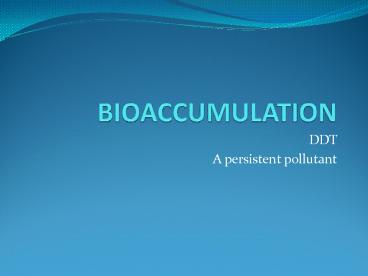BIOACCUMULATION - PowerPoint PPT Presentation
1 / 28
Title:
BIOACCUMULATION
Description:
DDT A persistent pollutant * In lesson three the students will work with an osprey dataset. To familiarize students with some of feeding habits of osprey,the example ... – PowerPoint PPT presentation
Number of Views:452
Avg rating:3.0/5.0
Title: BIOACCUMULATION
1
BIOACCUMULATION
- DDT
- A persistent pollutant
2
BIOACCUMULATION
- When a chemical pollutant enters an ecosystem
through accidental or deliberate discharge to the
soil, water or air, this chemical may enter the
food chain. - If it is not readily broken down by organisms, it
will accumulate and become progressively
concentrated as it enters organisms at higher
trophic levels. - This concentration is termed bioaccumulation or
biological magnification - Substances that cannot be excreted or broken down
by metabolism are non-biodegradable or
persistent. - Examples DDT, PCBs and dieldrin
3
DDT Background
- DDT is a pesticide used for mosquito control and
pest control in agricultural crops. - DDT accumulation in some bird species resulted in
death, nervous system damage, and reproductive
failure. - As a result DDT was banned in the United States
in 1972.
4
What kind of damage can DDT cause to birds?
5
In the body of an animal, DDT is changed
(metabolized) to DDE. DDE dissolves in fat,
not in water, and is stored in fatty tissues.
Thus, DDE tends to remain in the body and can
cause several problems.
6
DDE Kinds of Damage
- Reproductive failure (in birds- eggshell
thinning) - Immune system problems
- Nervous system damage
- Death
7
How does DDT move into lakes, streams and oceans?
8
- After DDT is applied, some DDT volatizes, some
remains on the plant, and some washes off the
plant into the soil, eventually making its way to
a stream, river, or lake. - The DDT that remains on the leaves of plants may
be ingested by primary consumers such as insects
and rodents. - DDT that has washed into a waterbody, remains in
the sediment or is consumed by bottom-feeding
organisms or absorbed by fish gills and skin.
9
Is DDT still used today?
10
- YES
- DDT is still used in some countries for insect
control on crops. - In countries where mosquitoes carry malaria, DDT
is currently used for mosquito control.
11
What is a Food Web?
12
Food Web A summary of the feeding relationships
within an ecological community.
Osprey
Sucker
Trout
Silverside
Bay Shrimp
Water Plants
ORGANIC DEBRIS
Plankton
13
Food Chain One thread of the food web
Osprey
Large Mouth Bass
Crayfish
ORGANIC DEBRIS
14
Cast of Food Web Characters
- Tertiary Consumers Animals that eat animals
that eat animals - Secondary Consumers Animals that eat animals
that eat plants - Primary Consumers Animals that eat plants
- Primary Producers Plants and Phytoplankton
organisms using the sun for energy
15
Why is food web knowledge important for
understanding the impact of DDT on ospreys and
eagles?
16
Ospreys and eagles are tertiary consumers and
this makes them particularly vulnerable to DDT
because of bioaccumulation and
biomagnification.
17
What is Bioaccumulation?
18
Bioaccumulation the accumulation of a
contaminant or toxin in or on an organism from
all sources (e.g., food, water, air). An
increase in the concentration of a chemical in a
biological organism over time, compared to the
chemical's concentration in the environment.
Compounds accumulate in living things any time
they are taken up and stored faster than they are
broken down (metabolized) or excreted.
19
What is biomagnification?
20
Biomagnification the increase in concentration
of toxin as it passes through successive levels
of the food webDDE accumulates at higher
levels in organisms that are higher in the food
chain
21
Biomagnification of a DDE in an Aquatic
Environment
Amount of DDE in Tissue
Level
Tertiary Consumer 3-76 µg/g ww (fish
eating birds)
Secondary Consumers 1-2 µg/g ww (large
fish)
Primary Consumers (small fish)
0.2-1.2 µg/g ww
Primary Producers (algae and aquatic plants)
0.04 µg/g ww
22
Considering biomagnification, how could DDE harm
an osprey?
23
Osprey Food Web
DDE Concentration
3-76 µg/g ww
Osprey
Large Mouth Bass
1-2 µg/g ww
0.2- 1.2 µg/g ww
Crayfish
Plant material and algae
0.04 µg/g ww
24
Units of Measurement
- 1 gram 1000 milligrams (mg) 1,000,000
micrograms (µg) - microgram (µg) one millionth of a gram
- To describe concentrations µg/g number of
micrograms - (of toxin) per gram (of tissue)
- 2 µg/g DDE in egg content means there is 2 parts
of DDE in 1,000,000 parts of an egg contents - ww or wet weight refers to the fresh weight of
animal tissue. - dw or dry weight refers to the weight of animal
tissue after it has been dried in an 65C oven to
remove all the water.
25
The Effects of DDE on Reproduction
Species Effect on Reproduction DDE Critical Concentration (measured in egg contents)
Bald Eagle None lt 3µg/g 1
Bald Eagle Failure 16 µg/g 1
Osprey Failure 17.6 µg/g 2
- Wiemeyer, S.N. et al., 1984. Organochlorine
pesticide, polychlorobiphenyl, and mercury
residues in bald eagles, 1969-1979, and their
relationship to shell thinning and reproduction.
Arch. Environ. Contam. Toxicol., 13, 529. - Johnson, D.R. et al., 1975. DDT and PCB levels in
Lake Coeur dAlene, Idaho osprey eggs, Bull.
Environ. Contam. Toxicol., 13, 401.
26
High levels of DDE cause the female ospreys to
lay eggs with thin eggshells.Thin eggshells
have a greater chance of breaking, leading to
embryo death.With high levels of DDE, female
ospreys can also lay eggs that contain high
enough concentration of DDE to prevent embryo
development.
27
How is the impact of DDE on osprey and eagle
reproduction measured?
28
One Method for Measuring the Impact of DDE on
Osprey Reproduction
- Collect eggs from abandoned osprey nests.
- Measure the thickness of the eggshells.
- Measure the amount of DDE in the egg.
- Determine the association between eggshell
thickness and DDE residue.































